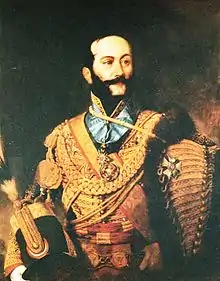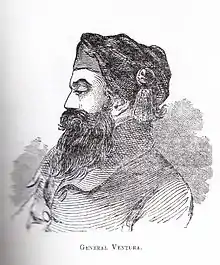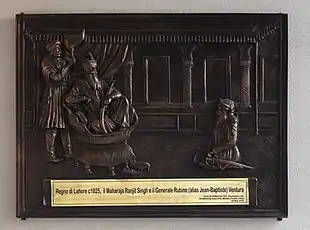Jean-Baptiste Ventura
Jean-Baptiste (Giovanni Battista) Ventura, born Rubino (25 May 1794–3 April 1858), was an Italian soldier, mercenary in India, and early archaeologist of the Punjab region of the Sikh Empire.

Life
Ventura was born in Finale Emilia in the Duchy of Modena to a Jewish father (and a catholic mother, Vittoria Massarani) and received a conventional Jewish education. At the age of seventeen, Ventura enrolled as a volunteer in the militia of the Kingdom of Italy and later served with Napoleon's imperial army in the Queens's Dragons. After the abdication of Napoleon and the dissolution of the Army of Italy in april 1814, he returned home. In 1817, his revolutionary and Napoleonic sympathies became known to the local authorities following a dispute between him and a member of the reactionary Ducal police. As such, he was obliged to leave the country.
He went first to Trieste, and then to Constantinople, where he was for a time a ship-broker. He changed his name in Jean-Baptiste to hide his jewish origin.
Learning that Persia was seeking the services of European soldiers, he obtained an officer's commission and helped to instruct the forces of the shah in European methods of warfare, soon becoming a colonel. Upon the death of the shah in 1822, Ventura offered his services to his successor, Abbas Mirza. In the latter's service, however, were a number of English officers who were decidedly hostile to the French; they considered Ventura to be French because he had fought under Napoleon. As a result of their political intrigues, Ventura was dismissed.
He travelled east, ending in Lahore with Jean-François Allard in 1822. They took service with the Maharaja Ranjit Singh of Punjab. In March the following year, they both held command in the Battle of Nowshera, where they defeated a combined Afghan force, resulting in Punjab's capture of Peshawar.
A rebellion having arisen in Afghanistan, Ventura conducted successfully several campaigns of a difficult nature, and greatly enlarged the boundaries of the kingdom of Lahore.
Together with Allard, Paolo Di Avitabile, and Claude August Court, Ventura formed the group of European mercenary officers responsible for the modernisation of the Sikh army. He also took responsibility for the training and command of the Fauj-i-Khas, the European model brigade. Ventura "reorganised the infantry into a formidable army including Gurkhas, Pathans, Biharis and Ooriyas."[1] He is also described as "the baron of the Fauj-i-Khas".
The Maharaja not only promoted Ventura to the rank of General, but also appointed him kazi and Governor of Lahore. He rose rapidly in the Darbar and virtually became the Commander in Chief of the Darbar forces.
Ventura married an Indian (or a local Armenian according other sources) lady, with whom he had a daughter, but he always longed to return to his native country. In 1837 he went on a diplomatic mission to Paris and London, but was recalled to Lahore before he had time to visit his family.

He spent his spare time in Peshawar exhuming Bactrian Greek and Kushan coins from Hindu temples and Buddhist stupas in the Khyber Pass, making numerous excavations then sending the findings on to the Asiatic Society of Bengal in Calcutta.
He served faithfully under Ranjit Singh and his successors Kharak Singh, Nau Nihal Singh, and Sher Singh. Upon Maharaja Sher Siṅgh's assassination in September 1843, he left the Punjab.
In France, he presented King Louis Philippe with a set of ancient Greek coins which he had unearthed. These coins were taken as evidence of Alexander the Great's march through Afghanistan and the Sindh-Punjab region of ancient India.
In his later years he lost a part of his large fortune in unsuccessful commercial enterprises. According to Flaminio Servi, Ventura received baptism toward the end of his life.[2]
He died on 3 April 1858 in Lardenne, near Toulouse, France.
MonumentOn
A monument donated by the Sikh community was inaugurated on May 26, 2019. It was placed in via Ventura in Finale Emilia opposite the house in which the General was born. It is a bas-relief which represents Ventura with Maraja Ranjit Singh with dimensions 160 x 120 cm, sculpted in India.

Awards
He received the French Legion of Honour from the king Louis Philippe I in 1835.
Notes
- Major Pearse, Hugh; Ranjit Singh and his white officers. In Gardner, Alexander (1999) [1898]. The Fall of Sikh Empire. Delhi, India: National Book Shop. ISBN 81-7116-231-2.
- VENTURA, RUBINO on "Jewish Encyclopedia"
Sources
- Balboni, Maria Pia; “Ventura. Dal ghetto del Finale alla corte di Lahore”, Biblioteca Nuova serie, Pagine VIII-212, Aedes Muratoriana, Modena, 1993;
- Balboni, Maria Pia, “Il generale Rubino Ventura. La straordinaria vita di un ebreo del Finale al servizio del maharaja Ranjit Singh”, Baraldini editore, Finale Emilia, 2019;
- Notizie Storiche e Biografiche del Generale Rubino Ventura, Finalese, Esposte da un Suo Concittadino, Finale (Emilia), 1882;
- F. Servi, in Corriere Israelitico, x. 47 et seq.;
- idem, in Vessillo Israelitico, xxxi. 308 et seq.;